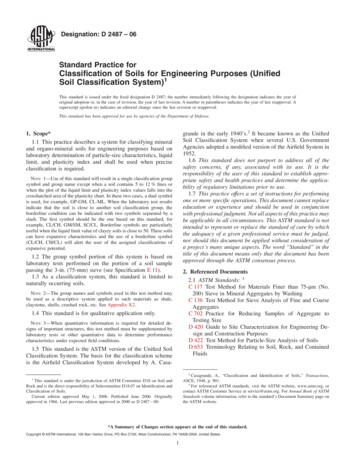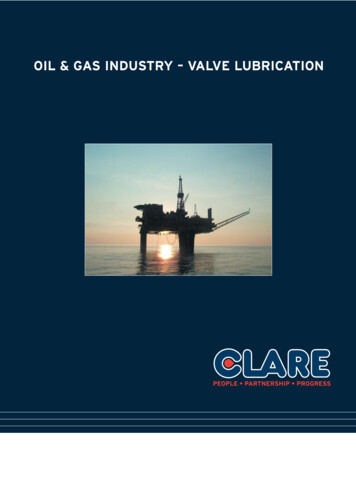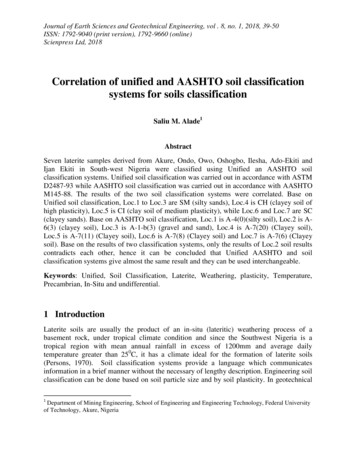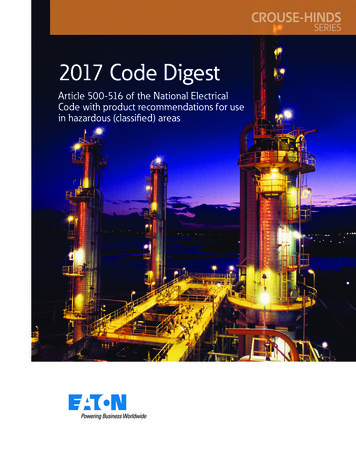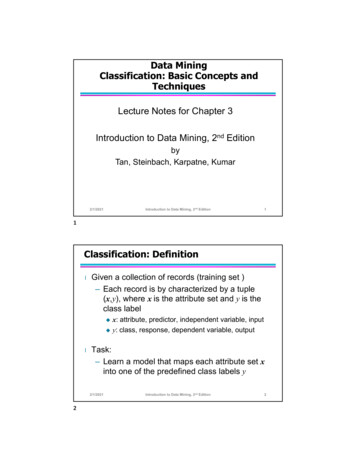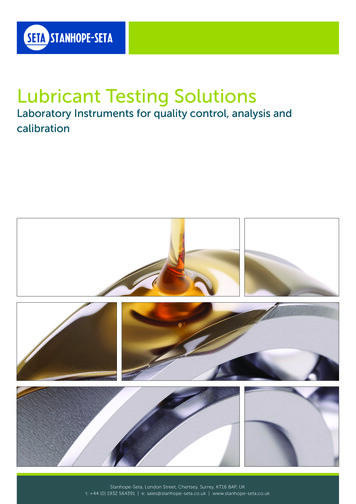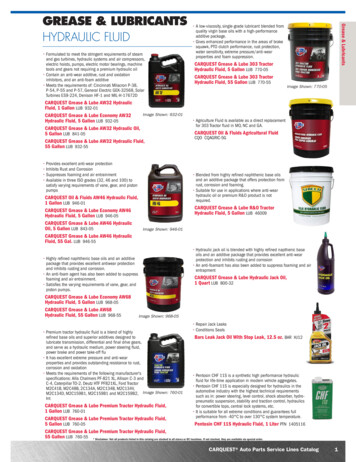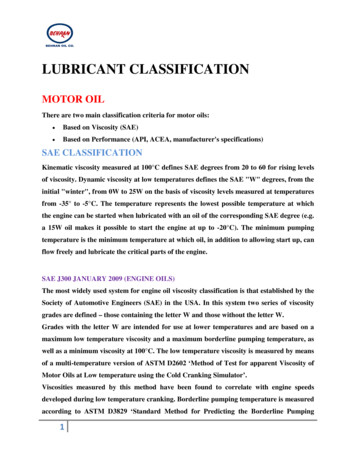
Transcription
LUBRICANT CLASSIFICATIONMOTOR OILThere are two main classification criteria for motor oils: Based on Viscosity (SAE) Based on Performance (API, ACEA, manufacturer's specifications)SAE CLASSIFICATIONKinematic viscosity measured at 100 C defines SAE degrees from 20 to 60 for rising levelsof viscosity. Dynamic viscosity at low temperatures defines the SAE "W" degrees, from theinitial "winter", from 0W to 25W on the basis of viscosity levels measured at temperaturesfrom -35 to -5 C. The temperature represents the lowest possible temperature at whichthe engine can be started when lubricated with an oil of the corresponding SAE degree (e.g.a 15W oil makes it possible to start the engine at up to -20 C). The minimum pumpingtemperature is the minimum temperature at which oil, in addition to allowing start up, canflow freely and lubricate the critical parts of the engine.SAE J300 JANUARY 2009 (ENGINE OILS)The most widely used system for engine oil viscosity classification is that established by theSociety of Automotive Engineers (SAE) in the USA. In this system two series of viscositygrades are defined – those containing the letter W and those without the letter W.Grades with the letter W are intended for use at lower temperatures and are based on amaximum low temperature viscosity and a maximum borderline pumping temperature, aswell as a minimum viscosity at 100 C. The low temperature viscosity is measured by meansof a multi-temperature version of ASTM D2602 ‘Method of Test for apparent Viscosity ofMotor Oils at Low temperature using the Cold Cranking Simulator’.Viscosities measured by this method have been found to correlate with engine speedsdeveloped during low temperature cranking. Borderline pumping temperature is measuredaccording to ASTM D3829 ‘Standard Method for Predicting the Borderline Pumping1
Temperature of Engine Oil’. This provides a measure of an oils’ ability to flow to theengine oil pump inlet and provide adequate engine oil pressure during the initial stages ofoperation.Oils without the letter W, intended for use at higher temperatures, are based on theviscosity at 100 C only. These are measured by ASTM D445 ‘Method of Test for KinematicViscosity of temperature and Opaque Liquids’.‘multi-grade’ oil is one whose low temperature viscosity and borderline temperature satisfythe requirements of one of the W grades and whose viscosity at 100 C is within thestipulated range of one-W-grades2
SAE J300 VISCOSITY GRADES FOR ENGINE OILS 12 (JANUARY 2015)SAEViscosityGradesLow Temperature( C)CrankingViscosity 3,mPa.s MaxLow Temperature( C)Pumping Viscosity,mPa.s MaxWith No Yield Stress 4Low-Shear-RateKinematicViscosity 5(mm2/s) at100 CMin.Low-Shear-RateKinematicViscosity5(mm2/s) at100 CMin.High-Shear-RateViscosity(6)6(mPa.s)at 150 CMin.0W6200 at-3560 000 at-403.8--5W6600 at-3060 000 at-353.8--10W7000 at-2560 000 at-304.1--15W7000 at-2060 000 at-255.6--20W9500 at-1560 000 at-205.6--25W13000 at-1060 000 at-159.3--8--4.0 6.11.712--5.0 7.12.016--6.1 8.22.320--6.9 9.32.630--9.3 12.52.93.5 (0W-40,40--12.5 16.35W-40 and10W-40 grades)3.7 (15W40,40--12.5 16.320W-40 ,25W-40, 40 grades)50--16.3 21.93.760--21.9 26.13.7121 mPa.s 1cP , mm /5 1 cStAll Values, With the exception of the low-temperature cranking viscosity, are critical specifications as definedby ASTM D3244 (See Text, section 3).3ASTM D5293:(Cold - Cranking Simulator) – The non-critical specification protocol in ASTM D3244: shall beapplied with a P value of 0.95.4ASTM D4684:(apparent viscosity) Note that the presence of any yield stress detectable by this methodconstitutes a failure regardless of viscosity.5ASTM D445: (Kinematic viscosity)6ASTM D4683: CEC L-36-A-90 (ASTM D4741),or ASTM D5481 (Tapered bearing or tapered plug methods )23
API CLASSIFICATIONAPI stands for American Petroleum Institute. In 1970 along with the SAE and ASTM(American Society for Testing and Materials), they established the API ServiceClassification System to define the performance level of a given oil, unrelated in the main,to oil viscosity.The API requirements “S” for Spark Ignition (petrol) and “C” for Compression Ignition(diesel) can be briefly described as follows. For automotive gasoline engines, the latestengine oil service category includes the performance properties of each earlier category. Ifan automotive owner’s manual calls for API SJ or SL oil, API SM oil will provide fullprotection. For diesel engines, the latest category usually – but not always – includes theperformance properties of an earlier category.4
GASOLINE ENGINESCategoryStatusServiceIntroduced in October 2010, designed to provide improved hightemperature despite protection for pistons, more stringent sludge control,and seal compatibility. API SN with resource Conserving matches ILSACGF-5 by combining API SN performance with improved fuel economy,turbocharger protection, emission control system compatibility, andprotection of engine operating on ethanol-containing fuels up to E85.For all automotive engines currently in use. Introduced in 2004, SM oils aredesigned to provide improved oxidation resistance, improved depositprotection, better wear protection, and better low-temperature performanceover the life of the oil. Some SM oils may also meet the latest ILSACspecification and/or qualify as Energy ConservingFor 2010 and older automotive engines.SNCurrentSMCurrentSLCurrentFor 2004 and older automotive engines.SJCurrentFor 2001 and older automotive engines.SHObsolete For 1996 and older engines.SGObsolete For 1993 and older engines.SFObsolete For 1988 and older engines.SEObsoleteSDCAUTION: Not suitable for use in gasoline-powered automotive enginesObsolete built after 1971. Use in more modern engines may cause unsatisfactoryperformance or equipment harm.SCCAUTION: Not suitable for use in gasoline-powered automotive enginesObsolete built after 1967. Use in more modern engines may cause unsatisfactoryperformance or equipment harm.SBCAUTION: Not suitable for use in gasoline-powered automotive enginesObsolete built after 1951. Use in more modern engines may cause unsatisfactoryperformance or equipment harm.SACAUTION: Contains no additives. Not suitable for use in gasoline-poweredObsolete automotive engines built after 1930. Use in more modern engines may causeunsatisfactory performance or equipment harm.CAUTION: Not suitable for use in gasoline-powered automotive enginesbuilt after 1979.Note: API intentionally omitted “SI” and “SK” from the sequence of categories.5
DIESEL oleteObsolete6ServiceIntroduced in 2006. For high-speed, four-stroke engines designed to meet 2007model year on-highway exhaust emission standards. CJ-4 oils are compoundedfor use in all applications with diesel fuels ranging in sulfur content up to 500ppm (0.05% by weight). However, use of these oils with greater than 15 ppm(0.0015% by weight) sulfur fuel may impact exhaust after treatment systemdurability and/or oil drain interval. CJ-4 oils are effective at sustaining emissioncontrol system durability where particulate filters and other advanced aftertreatment systems are used. Optimum protection is provided for control ofcatalyst poisoning, particulate filter blocking, engine wear, piston deposits, lowand high-temperature stability, soot handling properties, oxidative thickening,foaming, and viscosity loss due to shear. API CJ-4 oils exceed the performancecriteria of API CI-4 with CI-4 PLUS, CI-4, CH-4, CG-4 and CF-4 and caneffectively lubricate engines calling for those API Service Categories. Whenusing CJ-4 oil with higher than 15 ppm sulfur fuel, consult the enginemanufacturer for service interval.Introduced in 2002. For high-speed, four-stroke engines designed to meet 2004exhaust emission standards implemented in 2002. CI-4 oils are formulated tosustain engine durability where exhaust gas recirculation (EGR) is used and areintended for use with diesel fuels ranging in sulfur content up to 0.5% weight.Can be used in place of CD, CE, CF-4, CG-4, and CH-4 oils. Some CI-4 oilsmay also qualify for the CI-4 PLUS designation.Introduced in 1998. For high-speed, four-stroke engines designed to meet 1998exhaust emission standards. CH-4 oils are specifically compounded for use withdiesel fuels ranging in sulfur content up to 0.5% weight. Can be used in place ofCD, CE, CF-4, and CG-4 oils.Introduced in 1995. For severe duty, high-speed, four-stroke engines using fuelwith less than 0.5% weight sulfur. CG-4 oils are required for engines meeting1994 emission standards. Can be used in place of CD, CE, and CF-4 oils.Introduced in 1990. For high-speed, four-stroke, naturally aspirated andturbocharged engines. Can be used in place of CD and CE oils.Introduced in 1994. For severe duty, two-stroke-cycle engines. Can be used inplace of CD-II oils.Introduced in 1994. For off-road, indirect-injected and other diesel enginesincluding those using fuel with over 0.5% weight sulfur. Can be used in place ofCD oils.Introduced in 1985. For high-speed, four-stroke, naturally aspirated andturbocharged engines. Can be used in place of CC and CD oils.Introduced in 1985. For two-stroke cycle engines.Introduced in 1955. For certain naturally aspirated and turbocharged engines.CAUTION: Not suitable for use in diesel-powered engines built after 1990.CAUTION: Not suitable for use in diesel-powered engines built after 1961.CAUTION: Not suitable for use in diesel-powered engines built after 1959.
Through the years, lubricant users have been treated to a number of ways to designateviscosity grades of the lubricants used in manufacturing. There are SAE (Society ofAutomotive Engineers) grades for gear oils and crankcases (engines), AGMA (AmericanGear Manufacturers Association) grades for gear oils, SUS (Say bolt Universal Seconds),cSt (kinematic viscosity in centistokes), and absolute viscosity. To add to the confusion, twomeasures of temperature (Fahrenheit and Celsius) can be applied to most of these, not tomention that viscosity might be presented at either 40 C (104 F) or 100 C (212 F).While all of these have served useful purposes to one degree or another, most lubricationpractitioners settle on and use one method as a basis for selecting products. To the newentrant into the lubrication field, the number of options can be confusing, particularly ifthe primary lubricant supplier does not associate one of the prominent viscosity systems tothe product label. To complicate matters, machinery designers must define the lubricantviscosity in such a way that the equipment user understands clearly what is needed withouthaving to consult outside advice.These points to the need for a universally accepted viscosity designation - one that can beused by lubrication practitioners, lubricant suppliers and machinery design engineerssimultaneously with minimal confusion.ACEA CLASSIFICATIONACEA stands for Association des Constructers Europeans de l’Automobile. Thisclassification system is the European equivalent of the API classification system, but isstricter and has more severe requirements. Hence oil that meets both API and ACEAspecifications uses a better additive package than one that is designed to meet only APIspecifications. Unlike the API, ACEA has three main groups – “A/B” for gasoline and lightduty (passenger car, 4WD etc) diesel engines, “C” for light duty three way catalyst (TWC)and diesel particulate filter (DPF) compatible oils and “E” for heavy duty diesel engines.These can be defined as follows.7
The ACEA 2008 European Oil Sequences for Service-fill Oils comprise 3 sets (classes) ofsequences: one for Gasoline and Light-Duty Diesel engines; one specifically for Gasolineand Light-Duty Diesel engines with after treatment devices and one for Heavy-Duty Dieselengines. Within each of these sets there are categories which reflect different performancerequirements - four (A1/B1, A3/B3, A3/B4 & A5/B5) for gasoline and light-duty dieselengines; four (C1, C2, C3, C4) specifically for engines with after treatment devices, andfour (E4, E6, E7, E9) for heavy-duty diesel engines. Typical applications for each sequenceare described below for guidance only. Specific applications of each sequence are theresponsibility of individual engine manufacturers for their own vehicles / engines.The sequences define the minimum quality level of a product for self-certification toEELQMS and presentation to ACEA members. Performance parameters other than thosecovered by the tests shown or more stringent limits may be indicated by individual ACEAmember companies.Where claims are made that Oil performance meets the requirements of the ACEAsequences (e.g. product literature, packaging, labels) they must specify the ACEA Classand Category (see Nomenclature & ACEA Process for definitions).8
ACEA 2008 European Oil Sequences for Service-Fill OilsA1/В1А3/В3А3/В4А5/В5С1C2C3C49A/B : gasoline and diesel engine oilsStable, stay-in-grade oil intended for use at extended drain intervals in gasoline enginesand car & light van diesel engines specifically designed to be capable of using lowfriction low viscosity oils with a high temperature / high shear rate viscosity of 2.6mPa*s for xW/20 and 2.9 to 3.5 mPa.s for all other viscosity grades. These oils areunsuitable for use in some engines. Consult owner manual or handbook if in doubt.Stable, stay-in-grade oil intended for use in high performance gasoline engines and car& light van diesel engines and/or for extended drain intervals where specified by theengine manufacturer, and/or for year-round use of low viscosity oils, and/or for severeoperating conditions as defined by the engine manufacturer.Stable, stay-in-grade oil intended for use in high performance gasoline and directinjection diesel engines, but also suitable for applications described under A3/B3.Stable, stay-in-grade oil intended for use at extended drai
SAE J300 JANUARY 2009 (ENGINE OILS) The most widely used system for engine oil viscosity classification is that established by the Society of Automotive Engineers (SAE) in the USA. In this system two series of viscosity grades are defined – those containing the letter W and those without the letter W. Grades with the letter W are intended for use at lower temperatures and are based on a .
